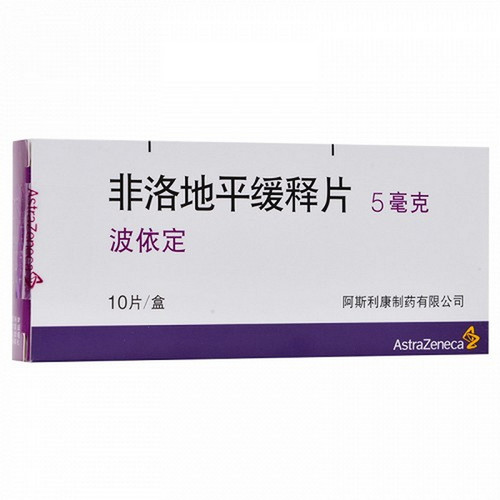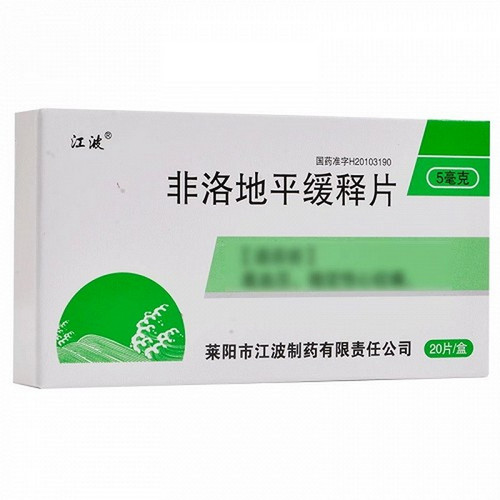Product Overview
[Drug Name]
Generic Name: Felodipine Extended-Release Tablets
Trade Name: Kangbao Dewei Felodipine Extended-Release Tablets 5mg x 10 Tablets
Pinyin Code: KangBaoDeWei FeiLuoDiPingHuanShiPian
[Main Ingredient]
The main ingredient of this product is felodipine. [Ingredient] Chemical Name: 2,6-Dimethyl-4-(2,3-dichlorophenyl)-1,4-dihydro-3,5-pyridinedicarboxylic acid methyl ethanol Molecular Formula: C₁₈H₁₉CI₂NO₄ Molecular Weight:
384.25
[Properties]
This product is a film-coated tablet that appears white or off-white after removal of the film coating.
[Indications/Main Functions]
Hypertension (can be used alone or in combination with other antihypertensive drugs).
[Specifications]
5mg x 10 tablets (Kangbao Dewei)
[Dosage and Administration]
Oral administration. Dosage should be individualized. The tablets should be taken in the morning with water. Do not break, crush, or chew them. 1. Treatment of Hypertension: The recommended starting dose is 5 mg once daily, with a typical maintenance dose of 5 or 10 mg once daily. The dose may be reduced or increased based on patient response, or other antihypertensive medications may be added. Dosage adjustments should generally be made at least every two weeks. For some patients, such as the elderly and those with impaired liver function, 2.5 mg once daily may be sufficient. Doses exceeding 10 mg once daily are generally not necessary. 2. Treatment of Angina: The recommended starting dose is 5 mg once daily, with a typical maintenance dose of 5 or 10 mg once daily. Renal impairment does not affect felodipine plasma concentrations, and no dose adjustment is required. Patients with severe renal impairment should use this product with caution.
[Adverse Reactions]
Common adverse reactions to this product include peripheral edema (mostly occurring 2-3 weeks after administration, with incidence related to age and dose), headache, and facial flushing. Peripheral edema is usually mild and related to age and dosage. Other symptoms include fatigue, fever, palpitations, nausea, indigestion, constipation, dizziness, paresthesias, upper respiratory tract infections, cough, runny nose, sneezing, rash, and gingival hyperplasia.
[Contraindications]
Felodipine is contraindicated in patients with hypersensitivity to felodipine, severe hypotension, or aortic stenosis.
[Drug Interactions]
1. Concomitant use of certain drugs that interfere with the cytochrome P450 3A4 enzyme system may affect the plasma concentration of dihydropyridine calcium antagonists, such as felodipine. Hepatic enzyme inhibitors (such as cimetidine, erythromycin, itraconazole, ketoconazole, and certain flavonoid compounds found in grapefruit juice) may increase felodipine plasma concentrations. Hepatic enzyme inducers (such as phenytoin, carbamazepine, rifampicin, and barbiturates) may decrease felodipine plasma concentrations. 2. Felodipine does not affect the plasma concentration of cyclosporine. 3. Although felodipine has a high degree of plasma protein binding, it does not affect the binding of other highly protein-bound drugs (such as warfarin). 4. No significant changes in the pharmacokinetic behavior of digoxin were observed when this drug was coadministered with digoxin in patients with heart failure. 5. This drug has no significant interactions with other drugs, such as indomethacin or spironolactone.
[Precautions]
1. This drug can cause severe hypotension and syncope, produce reflex tachycardia, and may cause angina in susceptible individuals. Use with caution in patients with hypotension. 2. This drug should be used with caution in patients with heart failure and cardiac insufficiency. Be aware of its negative inotropic effects, especially when used in combination with beta-blockers. 3. This drug should be used with caution in pregnant and lactating women and children. Elderly patients (over 65 years of age) or those with hepatic impairment should start treatment with a low dose (2.5 mg once daily) and closely monitor blood pressure during dose adjustment. 4. Clinical trials have shown that doses exceeding 10 mg daily may increase the antihypertensive effect, but also increase the incidence of peripheral edema and other vasodilatory adverse events. Patients with renal insufficiency generally do not require dose adjustment. 5. This product should be taken orally on an empty stomach or with a small, light meal. The tablet should be swallowed whole and not crushed or chewed. Maintaining good oral hygiene can reduce the incidence and severity of gingival hyperplasia.
[Pediatric Use]
There is limited experience with this product in children.
[Elderly Use]
Plasma concentrations of this product increase with age. Therefore, the recommended initial dose for elderly patients (over 65 years of age) is 2.5 mg daily, with dose adjustments based on individual response.
[Overdose]
1. Toxicity: 10 mg can cause mild toxicity in children under 2 years of age, 150-200 mg in children under 17 years of age, and 250 mg in adults. Compared with other similar drugs, felodipine may have more pronounced effects on peripheral vasculature than on the heart. 2. Symptoms: Symptoms of toxicity with this extended-release tablet may be delayed for 12 to 16 hours, and severe symptoms may develop several days later. 3. The greatest risk is associated with circulatory effects: bradycardia (sometimes tachycardia), atrioventricular block, atrioventricular dissociation, ventricular esophageal stenosis (VES), ventricular fibrillation, and cardiac arrest (asystole). Dizziness, headache, impaired consciousness, coma, and seizures. Dyspnea, pulmonary edema (non-cardiac), and apnea. Possible ARDS (adult respiratory distress syndrome). Acidosis, hypokalemia, hyperglycemia, potentially hypocalcemia, flushing, hypothermia, nausea, and vomiting. 4. Management: Activated charcoal and gastric lavage as indicated, and in some cases, at a later stage (extended-release tablets can aggregate). 5. Caution: (Due to the risk of vagal nerve stimulation) Atropine (0.25-0.5 mg IV for adults, 10-20 mg/kg for children) must be administered before gastric lavage. ECG monitoring should be performed, and mechanical ventilation should be used if indicated. Correction of acid-base and electrolyte status should be performed. For bradycardia and atrioventricular block, administer atropine 0.5-10 mg to adults.
[Pharmacology and Toxicology]
Pharmacological Action: This product is a dihydropyridine calcium channel antagonist (calcium channel blocker) that reversibly competes with nitrendipine and/or other calcium channel blockers for dihydropyridine binding sites. It blocks voltage-dependent Ca2+ currents in vascular smooth muscle and cultured rabbit atrial cells, and blocks K+-induced portal vein contracture in rats. In vitro studies have demonstrated that this product has a selective inhibitory effect on vascular smooth muscle over myocardium. Negative inotropic effects have been detected in vitro, but not in whole animals.







